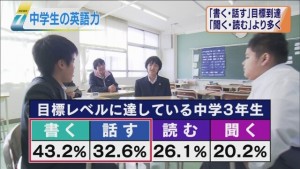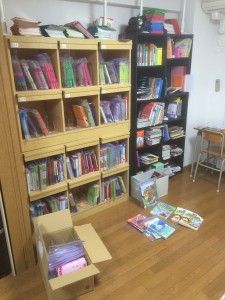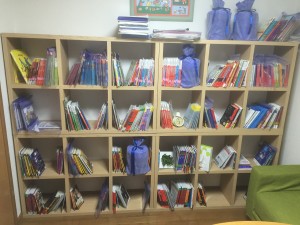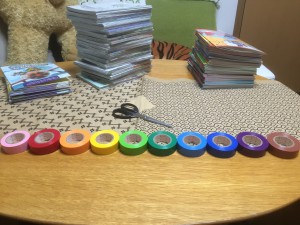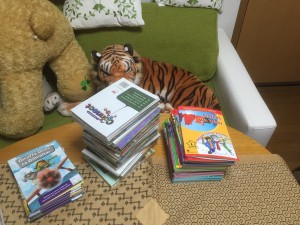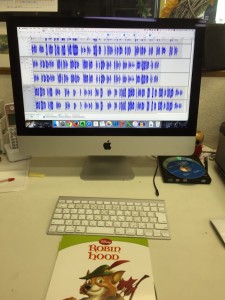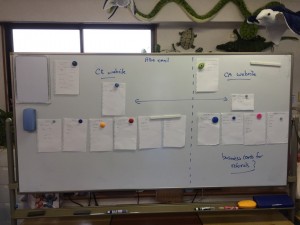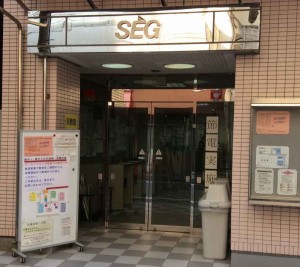PRESENTATION: Oxford Teaching Workshop Series in Sendai, February 14th
What else could you be doing on Valentine’s Day?
I’ll be presenting at the Oxford Teaching Workshop Series in Sendai this weekend, talking about reading programs for young learners. It’ll be a very practical, nuts and bolts type presentation.
10:30-11:20
Venue: TKP Garden City Sendai Hall C
“Many teachers are aware of the benefits of reading in English and would like to start reading programs for their students, but the practical difficulties seem too great. From budgeting to choosing books to planning and explaining class activities, this workshop will provide very specific advice for teachers who want to start or expand a reading program.”
More importantly though, my friend Yuko Suzuki will be talking about Shadoku (shadowing tadoku, or extensive reading) from 13:30. Anyone interested in the intersection between reading, speaking, and young learners should attend her workshop. She’ll be speaking in Japanese, but it’s worth making the effort to attend. I’m particularly pleased because I think I coined the term ‘shadoku’ over lunch at an ER event in Fukuoka. Glad to see Yuko running with it 🙂
curriculum extensive listening extensive reading public policy
by sendaiben
4 comments
English Skills of Japanese Students
Business as Usual
Japan Times article. NHK puts a positive spin on the data. Less positive commentary.
Apart from unsurprised disappointment, my first reaction is to question what exactly the government thinks the equivalent of Eiken 3, pre-2, or 2 writing skills are that 40-odd percent of students have (given that these tests don’t have a writing section).
Is it that ridiculous ‘rearrange these words in the right order’ section? Because if they were using the words ‘writing skills’ in the form that the rest of the world understands, I think it would be a struggle for any Japanese junior and senior high school students to demonstrate proficiency.
I wrote about English education in Japan a couple of years ago in my ‘if I ruled the world’ series:
I don’t think a huge amount has changed since I wrote those. One thing that has changed for me is seeing how effective an extensive reading and listening course is. I will be doubling my efforts to get local schools to start their own programs -wish me luck.
curriculum extensive reading high school junior high school school management
by sendaiben
6 comments
Cambridge Academy: Year One
This is the third post about the Cambridge Academy, a private English program for junior and senior high school students. You can read the introductory post here, and the six-month update here.
The Academy started in April 2015, so this is the eleventh month of operation. It seems like a good point to review the year and talk about what we have learned since the last update.
The Good
There have been several positive developments. Best, and most important, of all is that our current students still seem to be enjoying their classes and reading well as far as I can tell. We have a range of outcomes depending on motivation, how often the students miss class, and ability, but even the least motivated students have read around 40,000 words this year. The students I mentioned in the last update who had run into problems now seem to be back on track.
We have figured out what to do with intermediate students. Once students go past YL 1.0 we class them as intermediate and give them more freedom to choose books. Up until 1.0 we do ‘guided ER’: class teachers give them their reading material and keep track of what they have read. Once they become intermediate they can choose their own books (teachers give advice until they get used to taking responsibility for their reading) within an appropriate level range.
Levels are now indicated with coloured vinyl tape. We use ten colours for beginner, and the same ten colours for intermediate and above, as follows:
Colour – Beginner YL – Intermediate+ YL
- Pink – 0.1 – 1.1-1.2
- Red – 0.2 – 1.3-1.4
- Orange -0.3 – 1.5-1.9
- Yellow -0.4 – 2.0-2.4
- Light Green – 0.5 – 2.5-2.9
- Green – 0.6 – 3.0-3.9
- Light Blue – 0.7 – 4.0-4.9
- Blue – 0.8 – 5.0-5.9
- Purple – 0.9 – 6.0-6.9
- Brown – 1.0 – 7.0+
The tape is easily available on Amazon or in stores. Putting it on books and ziplock bags is a bit of a pain, but it really helps teachers put beginner sets back in the right place quickly, and students find books at an appropriate level in the intermediate levels.
The reason I use tape and not stickers, despite the extra time it takes to measure and cut the tape, is that it is far more durable and pretty much doesn’t fall off (unlike the stickers).
We had some very good explanatory sessions with parents and students (sanshamendan) where we asked parents to come in for fifteen minutes and gave them a quick status report on how their child was doing. I was able to share their reading numbers and talk about what we do in class. This also gave parents a chance to ask questions or raise concerns, and a few of them did which meant we were able to set their minds at ease. We did the sessions over a number of weeks in November and December. I’m not sure if we will be able to continue doing them if student numbers grow, but will try to do something similar at least for all students in their first year.
We have bought a lot more books. We took delivery of about 1000 in January, and I am nowhere near caught up on labeling them and sorting out the audio. The good thing is that I think we’re probably okay for breadth at the beginner levels now. The next thing is to work on the intermediate levels, particularly on getting really appealing series of books, so that students can find something they like and read lots of similar content.
The Bad
Somewhat predictably, we are still finding it hard to recruit students from outside of Cambridge English, the parent English school. I was hoping to have grown the student body to around one hundred by the end of this first year, but instead we have seen slight attrition as students quit to focus on entry tests, move away, or get busy with other activities.
Student numbers fell by about 15% as current students decided they didn’t like the new system (fair enough as most of them were in normal eikaiwa classes when we unilaterally moved them to the new Academy format). We have another 10% or so who will graduate and go away to university. Somewhat making up for that, we have up to 40% who will come up from Cambridge English, and about 10% of new students who have booked trial lessons this month.
If all goes very well, we should end up with slightly more students than we had this time last year.
We weren’t able to redesign the website last year so that is a future project.
What happens next?
Well, the most urgent thing right now is to make sure the current students stay and as many prospective new students as possible join. We also need to tweak the program slightly to move writing practice into the ‘output’ classes and reduce the amount of formal homework students have. This year we found that most students did not do homework, which interfered with the smooth running of classes. Next year we will have no set homework but instead introduce lots of opportunities for language practice so that more motivated students can do it and the others don’t feel they have to.
I am really looking forward to seeing the students’ progress going forward. We have half a dozen now who are into our intermediate level, having read 300,000 words+. I am hoping that we (and they) will start seeing results in terms of their school studies and general English proficiency. This is where the program is going to live or die, and where our future students are going to come from. It will also make all the hard work worthwhile.
I imagine we will continue buying books too 🙂
business curriculum extensive listening extensive reading high school junior high school school management self-study
by sendaiben
11 comments
Cambridge Academy (six months in)
Extensive Reading for Secondary Students Part 2
Well, we’ve been running the Cambridge Academy for about six months now.
Academy classroom
Cambridge Academy (see previous write-up here): so far so good. We’ve run into some problems and changed course a couple of times, but the program is shaping up and it’s time for a big recruitment push. In this post I will talk about some hiccups we encountered, solutions, and future plans.
Problems so far
1. We still don’t have enough books
2. Some books don’t have commercially available audio
3. We don’t have a coherent program beyond the beginner level (over YL0.9)
4. Some students (10%>) are not performing well
5. Writing activities are not a good fit for an extensive reading class
Solutions
1. We continue to buy books and process existing ones (label and put into database and reading checklists) so that students can use them. We’ve probably doubled our existing readers since April and will probably continue doing this for the foreseeable future. Practice is making better, and our processing is getting much quicker now.
Processing new books
Processing new books involves the following steps:
- open box, remove plastic wrapping etc.
- find YL/word count information
- label books with SEG labels
- input book information into our reader database
- copy CDs and put away the masters
- put books and CDs into ziplock bag sets
- add book/set information to reading checklists
- put books on the shelves
The two major problems are if books don’t have YL/word count information, and if books don’t have CDs/audio. Right now we guesstimate YL and count words if the books are short enough. For longer books we try to find the word counts online. This site is great to find US-published series.
2. For books with no commercial audio available, we have been making our own by reading the books out loud into an iMac using Audacity to produce mp3 files that we then burn to CDs using iTunes. So far this is working very well, but it takes quite a long time and we still have over 500 books to make CDs for!
Recording audio
3. None of our students have gone beyond YL1.0 yet, but a couple of them will reach it soon. Before that happens we need to make sure we have enough books for them to read. Another problem is what to do about audio. I suspect that by the time students go over YL1.0 audio will be less important, but I am not 100% sure.
The other question is whether to continue grouping books into sets or to move to having individual books. If individual books, what will the checklists look like? I suspect all of this will get worked out over the next six months or so.
4. We have two problems with some of our students. The first is that a small number of students (two or three) seem to be exaggerating the amount they read or reading in a very perfunctory way (just looking at the pictures). I’m not sure how much of a problem this is, as they may well still be getting some benefit from the audio input. If it is a problem, I don’t really know what to do about it. I have tried talking to them, asking them about the content of books, and had them read the books out loud to me, but I am still not happy about the situation. Work in progress.
The other problem is potentially more serious. So far only one student seems to have run into it. Basically the student seems to have hit a wall around YL0.3, and is reporting that they cannot understand anything in the books at that level. I have tried talking to the student and explaining that it’s not necessary to understand everything but rather important to try and catch familiar words and think about the meaning, but I am not sure how helpful that was or how to solve this if it comes up with other students. Another work in progress.
5. Our initial model bundled extensive reading and writing practice (through weekly writing assignments) into one class, with speaking activities in the other. However, this model has several important drawbacks and we’ll be changing it in the future. Our ER classes have up to 12 students in them, so checking each student’s writing in 55 minutes is really hard and quite stressful for the teacher. Checking writing assignments in the ER class also means that our teaching assistants cannot take the class (they would be able to if it was just ER). Finally, having writing assignments in the ER class makes the class more stressful and less fun. Students are worried about finishing their writing instead of just relaxing and enjoying the reading class.
From next year we will include the writing assignments in the communication class (output), while the ER class will focus on reading and listening to the accompanying CDs.
Future plans
We have a few plans not mentioned above. The first and most important is that now that the program is getting into a half-decent shape, it’s time to try to expand it and recruit more students. So far all our students joined from within the school. Only half a dozen or so joined the school once the Academy was running, and we haven’t been actively advertising the course.
Business cards for advertising
From this week we will start actively trying to recruit new students, through our new Academy webpage and various advertising campaigns. Our goal is to have 100 students in the Academy by December 15th this year.
Planning the new website
Our website is getting a bit dated so we plan to get a new one made in November this year.
We are also going to explore whether the ER class is a standalone product. At first we went off the SEG model, which pairs an ER class with a communication class, but my friend DE suggested that the ER class might be our main product, with the communication class as an optional extra. This would be much easier to provide logistically, so I am excited to see if it is true over the next couple of months.
Another thing that we need to work on is making the ER classroom more comfortable. Right now it is set up with school-style desks and chairs, but we are planning to make more of a cafe-style with more comfortable chairs and funkier design/lighting/etc. Ideally it should be a welcoming space that students want to spend time in, and prospective students are attracted to. Work in progress, but I hope to post some pictures in the next update.
We need to find another couple of teaching assistants so we can train them before expanding the number of classes. We’re looking for 2nd-year university students at the moment.
Eventually we are hoping to open new branches in other parts of the city. I think that will be an option once we have 200 students at the original location. Another work in progress!
Any questions or advice? Please comment below.
More on SEG
I wrote about SEG last year, and about our new program (based on SEG’s approach) a couple of months ago.
Joseph Poulshock has now written a great post on a high school student lesson he observed at SEG. I think it captures the atmosphere well, and is well worth a read.
